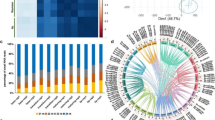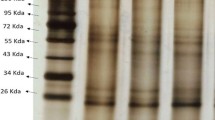Abstract
Tilapia is an important freshwater aquaculture species worldwide. In recent years, streptococcal diseases have severely threatened development of tilapia aquaculture, while effective prevention and control methods have not yet been established. In order to understand the immunological response of tilapia to infection by Streptococcus agalactiae (S. agalactiae), this study employed Solexa/Illumina RNA-seq and digital gene expression (DGE) technology to investigate changes in the tilapia transcriptome before and after S. agalactiae infection. We obtained 82,799 unigenes (mean size: 618 bp) using de novo assembly. Unigenes were annotated by comparing against databases including Nr, Swissprot, cluster of orthologous groups of proteins, Kyoto encyclopedia of genes and genomes, and gene ontology. Combined with DGE technology, transcriptomic changes in tilapia before and after bacteria challenging were examined. A total of 774 significantly up-regulated and 625 significantly down-regulated unigenes were identified, among which 293 were mapped to 181 signaling pathways including 17 immune-related pathways involving 65 differentially expressed genes. We observed a change in the expression of six genes in the Toll-like receptor signaling pathway, and this was subsequently confirmed via quantitative real-time PCR. This comparative study of the tilapia transcriptome before and after S. agalactiae infection identified important differentially-expressed immune-related genes and signaling pathways that will provide useful insights for further analysis of the mechanisms of tilapia defense against S. agalactiae infection.





Similar content being viewed by others
References
Ye X, Li J, Lu M, Deng G, Jiang X, Tian Y, Quan Y, Jian Q (2011) Identification and molecular typing of Streptococcus agalactiae isolated from pond-cultured tilapia in China. Fisheries Sci 77:623–632
Quail MA, Kozarewa I, Smith F, Scally A, Stephens PJ, Durbin R, Swerdlow H, Turner DJ (2008) A large genome center’s improvements to the Illumina sequencing system. Nat Methods 5:1005–1010
Meyer M, Stenzel U, Hofreiter M (2008) Parallel tagged sequencing on the 454 platform. Nat Protoc 3:267–278
Mardis ER (2008) The impact of next-generation sequencing technology on genetics. Trends Genet 24:133–141
Shendure J (2008) The beginning of the end for microarrays? Nat Methods 5:585–587
Wang Z, Gerstein M, Snyder M (2009) RNA-Seq: a revolutionary tool for transcriptomics. Nat Rev Genet 10:57–63
Huang W, Liang X, Qu C, Cao J, Zhao C, Cao L (2013) Development and characterization of novel polymorphic microsatellite loci in Siniperca scherzeri Steindachner and Siniperca chuatsi (Basilewsky). Mol Biol Rep 40:751–756
Hegedus Z, Zakrzewska A, Agoston VC, Ordas A, Rácz P, Mink M, Spaink HP, Meijer AH (2009) Deep sequencing of the zebrafish transcriptome response to mycobacterium infection. Mol Immunol 46:2918–2930
Ordas A, Hegedus Z, Henkel CV, Stockhammer OW, Butler D, Jansen HJ, Racz P, Mink M, Spaink HP, Meijer AH (2011) Deep sequencing of the innate immune transcriptomic response of zebrafish embryos to Salmonella infection. Fish Shellfish Immunol 31:716–724
Mu Y, Ding F, Cui P, Ao J, Hu S, Chen X (2010) Transcriptome and expression profiling analysis revealed changes of multiple signaling pathways involved in immunity in the large yellow croaker during Aeromonas hydrophila infection. BMC Genomics 11:506
Xiang LX, He D, Dong WR, Zhang YW, Shao JZ (2010) Deep sequencing-based transcriptome profiling analysis of bacteria-challenged Lateolabrax japonicus reveals insight into the immune-relevant genes in marine fish. BMC Genomics 11:472
Conesa A, Gotz S, Garcia-Gomez JM, Terol J, Talon M, Robles M (2005) Blast2GO: a universal tool for annotation, visualization and analysis in functional genomics research. Bioinformatics 21:3674–3676
Ye J, Fang L, Zheng H, Zhang Y, Chen J, Zhang Z, Wang J, Li S, Li R, Bolund L, Wang J (2006) WEGO: a web tool for plotting GO annotations. Nucleic Acids Res 34:293–297
Morrissy AS, Morin RD, Delaney A, Zeng T, McDonald H, Jones S, Zhao Y, Hirst M, Marra MA (2009) Next-generation tag sequencing for cancer gene expression profiling. Genome Res 19:1825–1835
Audic S, Claverie JM (1997) The significance of digital gene expression profiles. Genome Res 7:986–995
Benjamini Y, Yekutieli D (2001) The control of the false discovery rate in multiple testing under dependency. Ann Stat 29:1165–1188
Schmittgen TD, Kenneth J, Livak KJ (2008) Analyzing real-time PCR data by the comparative CT method. Nat Protoc 3:1101–1108
Livak KJ, Schmittgen TD (2001) Analysis of relative gene expression data using real-time quantitative PCR and the 2−ΔΔCT method. Methods 25:402–408
Maisey HC, Doran KS, Nizet V (2009) Recent advances in understanding the molecular basis of group B Streptococcus virulence. Expert Rev Mol Med 10:e27
Devi AS, Ponnuraj K (2010) Cloning, expression, purification and ligand binding studies of novel fibrinogen-binding protein FbsB of Streptococcus agalactiae. Protein Expr Purif 74:148–155
Wu Z, Zhang W, Lu Y, Lu C (2010) Transcriptome profiling of zebrafish infected with Streptococcus suis. Microb Pathog 48:178–187
Dumrongphol Y, Hirota T, Kondo H, Aoki T, Hirono I (2009) Identification of novel genes in Japanese flounder (Paralichthys olivaceus) head kidney up-regulated after vaccination with Streptococcus iniae formalin-killed cells. Fish Shellfish Immunol 26:197–200
Floege J, Lüscher B, Müller-Newen G (2012) Cytokines and inflammation. Eur J Cell Biol 91:427
Banyer JL, Hamilton NHR, Ramshaw IA, Ramsay AJ (2000) Cytokines in innate and adaptive immunity. Rev Immunogenet 2:359–373
Covello JM, Bird S, Morrison RN, Battaglene SC, Secombes CJ, Nowak BF (2009) Cloning and expression analysis of three striped trumpeter (Latris lineata) pro-inflammatory cytokines, TNF-α, IL-1β and IL-8, in response to infection by the ectoparasitic, Chondracanthus goldsmidi. Fish Shellfish Immunol 26:773–786
Laing KJ, Secombes CJ (2004) Chemokines. Dev Comp Immunol 28:443–460
Kawai T, Akira S (2009) The roles of TLRs, RLRs and NLRs in pathogen recognition. Int Immunol 21:317–337
Geijtenbeek TB, Gringhuis SI (2009) Signalling through C-type lectin receptors: shaping immune responses. Nat Rev 9:465–479
Mogensen TH (2009) Pathogen recognition and inflammatory signaling in innate immune defenses. Clin Microbiol Rev 22:240–273
Palti Y (2011) Toll-like receptors in bony fish: from genomics to function. Dev Comp Immunol 35:1263–1272
Trinchieri G, Sher A (2007) Cooperation of Toll-like receptor signals in innate immune defence. Nat Rev 7:179–190
Meijer AH, Gabby Krens SF, Medina RI, He S, Bitter W, Snaar-Jagalska BE, Spaink HP (2004) Expression analysis of the Toll-like receptor, TIR domain adaptor families of zebrafish. Mol Immunol 40:773–783
Baoprasertkul P, Peatman E, Abernathy J, Liu Z (2007) Structural characterisation, expression analysis of Toll-like receptor 2 gene from catfish. Fish Shellfish Immunol 22:418–426
Rodriguez MF, Wiens GD, Purcell MK, Palti Y (2005) Characterization of Toll-like receptor 3 gene in rainbow trout (Oncorhynchus mykiss). Immunogenetics 57:510–519
Baoprasertkul P, Peatman E, Somridhivej B, Liu Z (2006) Toll-like receptor 3, TICAM genes in catfish: species-specific expression pro-files following infection with Edwardsiella ictaluri. Immunogenetics 58:817–830
Shaw PJ, Lamkanfi M, Kanneganti TD (2010) NOD-like receptor signaling beyond the inflammasome. Eur J Immunol 40:624–627
Chen G, Shaw MH, Kim YG, Nuñez G (2009) NOD-Like Receptors: role in innate immunity and inflammatory disease. Annu Rev Pathol Mech Dis 4:365–398
Kanneganti TD, Lamkanfi M, Núñez G (2007) Intracellular NOD-like receptors in host defense and disease. Immunity 27:549–559
Hewitt EW (2003) The MHC class I antigen presentation pathway: strategies for viral immune evasion. Immunology 110:163–169
Gao Y, Wahlberg P, Marthey S, Esquerré D, Jaffrézic F, Lecardonnel J, Hugot K, Rogel-Gaillard C (2012) Analysis of porcine MHC using microarrays. Vet Immunol Immunopathol 148:78–84
Gold MC, Robinson TL, Cook MS, Byrd LK, Ehlinger HD, Lewinsohn DM, Lewinsohn DA (2007) Human neonatal dendritic cells are competent in MHC Class I antigen processing and presentation. PLoS One 9:e957
Davis MM (2002) A new trigger for T cells. Cell 110:285–287
Meeker ND, Smith AC, Frazer JK, Bradley DF, Rudner LA, Love C, Trede NS (2010) Characterization of the zebrafish T cell receptor beta locus. Immunogenetics 62:23–29
Tybulewicz VL, Ardouin L, Prisco A, Reynolds LF (2003) Vav1: a key signal transducer downstream of the TCR. Immunol Rev 192:42–52
Mustelin T, Rahmouni S, Bottini N, Alonso A (2003) Role of protein tyrosine phosphatases in T cell activation. Immunol Rev 191:139–147
Acknowledgments
This work was supported by grants from the National High-tech R&D Program of China (863 Program, No.2011AA100404), National Natural Science Foundation of China (N0.31272688) and China Agriculture Research System (CARS-49). We would like to thank Dr. Mark R. Liles at Auburn University, US for editorial help.
Author information
Authors and Affiliations
Corresponding author
Rights and permissions
About this article
Cite this article
Zhang, R., Zhang, Ll., Ye, X. et al. Transcriptome profiling and digital gene expression analysis of Nile tilapia (Oreochromis niloticus) infected by Streptococcus agalactiae . Mol Biol Rep 40, 5657–5668 (2013). https://doi.org/10.1007/s11033-013-2667-3
Received:
Accepted:
Published:
Issue Date:
DOI: https://doi.org/10.1007/s11033-013-2667-3




